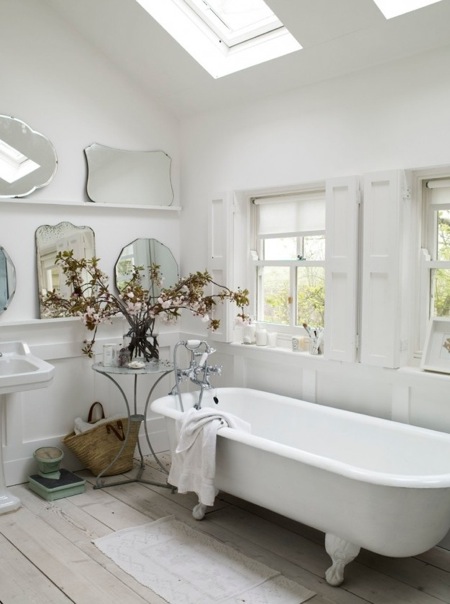 |
| image via Marston & Langinger |
If you are moving into a new home, decorating your nursery, renovating your existing home or just renovating some old furniture there are a few things you should consider when it comes to paints and finishes.
Materials such as paints, stains, varnishes, carpets, new furniture and kitchen joinery contain compounds that "off-gas" over a period of time producing poor air quality in your home.
A simple example of this is the odour from fresh paint. The smell will dissipate but the compounds will continue to "off-gas" for years after the products or materials are initially installed. For more detail see the image below from Green Painters.
 |
| for more details click here at Green Painters |
Believe it or not some paints are healthier than others.
I often hear people say... “I love that new home smell” when their walls have been freshly painted or when their timber floor has been sanded, sealed and polished.
I often hear people say... “I love that new home smell” when their walls have been freshly painted or when their timber floor has been sanded, sealed and polished.
That “new smell” is likely to be the product of VOC off gassing and is actually toxic gases released into the air.
You may ask what is a VOC...?
VOC is short for Volatile Organic Compound. If you would like to learn more about air quality & Volatile Organic Compounds click here.
Otherwise I will try to explain... Regular paints, the sort we normally buy from our local hardware store, are made from a cocktail of petrol based products and chemicals and can give off differing levels of toxic fumes called VOC’s into the environment that can cause symptoms such as breathing and respiratory irritations and headaches.
From the time when these paints and finishes are applied they continue to release their highest levels of emission over the first year and then continue to release lower emissions for years after the first application.
New environmental regulations and consumer demand have led to the availability of a range of healthier paint options from organic and natural paints to zero VOC and low VOC paint products.
If these healthier paints are used along with choosing low VOC finishes, low formaldehyde materials and natural furnishings a newly decorated room should have no smell or odour.
An example of a project where I have used a range of low VOC and natural paints is “Three Little girls and a Boy named Ted”.
TYPES OF NON-TOXIC PAINTS
Natural Paints
- Many of these ingredients are made from renewable resources and natural raw ingredients such as water, plant oils and resins, plant dyes, natural minerals such as clay, chalk, milk casein, bees' wax, earth and mineral dyes.
- These are ideal for residential applications, or for use when chemical sensitivity is an issue or sustainability is the main focus.
Zero or Low VOC Paints
- More of a traditional water based or acrylic paint product and ideal for residential and commercial applications.
- These products can be quick drying, better to clean and have a higher UV resistance.
- For chemical sensitivity use Zero or Low VOC paint (less than 1 gram/litre).
Some major paint manufacturers in Australia still use tints that contain high levels of VOC'S. With all paints you can ask for a product's technical data sheet that will explain the VOC level within the product.
With products that brand themselves as “Low VOC” on the tin it is still worth checking what the final VOC level is after a tint is added. When tints are added the VOC value may increase and therefore the original VOC level cannot be guaranteed.
PAINT MANUFACTURE AND SUSTAINABILITY
 |
| for more details click here at Green Painters |
Another thing to think about is that just because the paint is classed "low VOC" it does not mean that the product has a low environmental impact. The whole life cycle of the product needs to be considered:
- Does the product come from a renewable resource?
- How much water is needed to make the product?
- How much energy is used in producing the product?
- Can the product be disposed of with a low environmental impact method?
- Can the product or it's waste be recycled?
There are now eco labels that can help you identify how sustainable a product is. This labeling system will vary from country to country but shows if a product has passed a comprehensive sustainable life-cycle based assessment.
Here in Australia just look for the label below...
GREEN PAINTERS
Green painters and decorators are now becoming much more popular. When selecting low VOC or natural paints I always try to use green painters and tradesmen that are familiar with using these natural products. The benefits of this are that:
- Your painter is qualified and trained to apply these products.
- Your painter uses waste-water minimization and disposes of painting waste correctly within EPA guidelines.
- You know that your paint will not be swapped for a cheaper brand.
WHY NATURAL or LOW VOC PAINTS?
- Natural finishes, allergy safe & toxin-free.
- No fumes or smells - healthier on your family and colleagues.
- Sustainable life-cycle managed product.
As more products are available on the market more people are asking for natural alternatives to protect the health of their children and colleagues. By selecting products that are non-toxic and low VOC you are improving the quality of your air within your home and selecting a more sustainable product.
 |
| the beautiful Sistine Chapel - painted between 1508-1512 |
Have fun.














